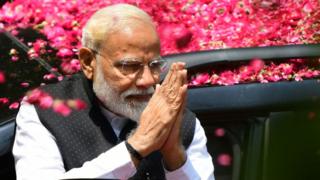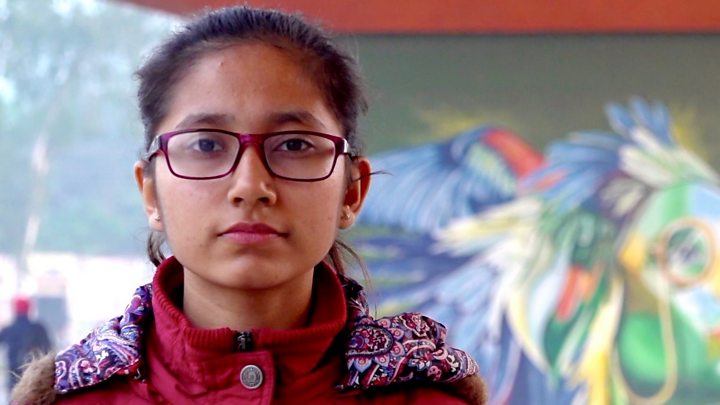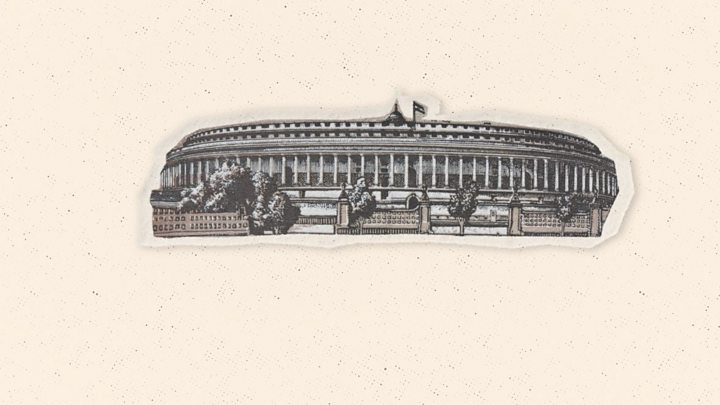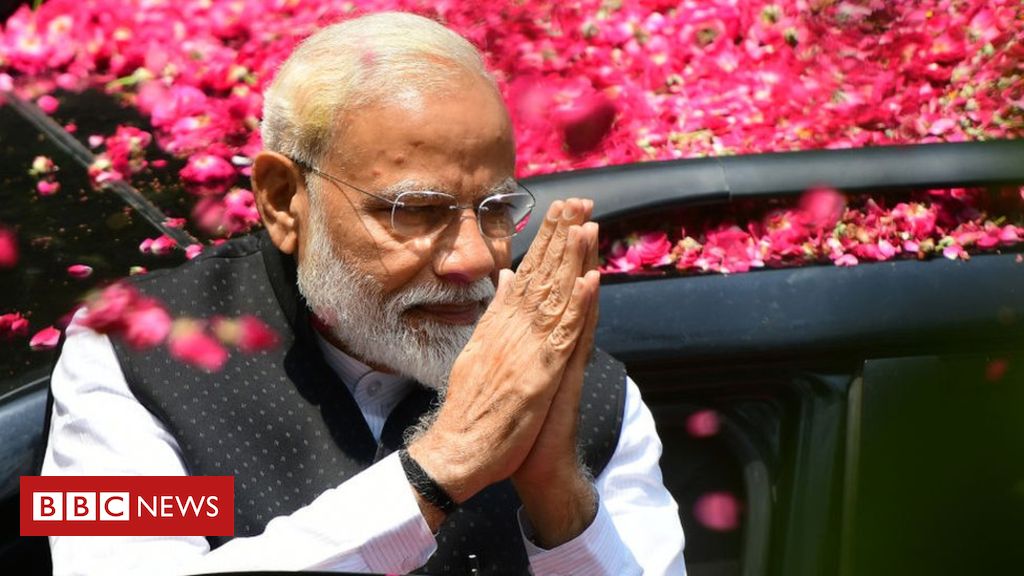 Image copyright
Image copyright
Getty Images
Prime Minister Narendra Modi’s Varanasi seat is up for grabs as Indians vote in the last phase of the general election.
Mr Modi’s Bharatiya Janata Party (BJP) and the main opposition Congress party are battling it out with powerful regional rivals in what analysts believe will be a close fight.
Many see this election as a referendum on Mr Modi who won a landslide in 2014.
Results will be announced on 23 May, drawing to an end six weeks of voting and a long, bruising campaign.
Sunday’s voting will take place in 59 seats, including Mr Modi’s constituency Varanasi, a holy Hindu city in the bellwether northern state of Uttar Pradesh.
Image copyright
Getty Images
Rahul Gandhi and his sister, Priyanka, belong to the fourth generation of the Nehru-Gandhi political dynasty
The BJP is hoping to repeat its 2014 performance when it won 282 seats, the biggest victory by any party in 30 years. The Congress, which won just 44, suffered its worst defeat.
A party needs at last 272 seats to claim a majority in the 543-member lower house of parliament, or Lok Sabha.
India votes 2019
Mr Modi, with his tough image, remains the BJP’s main vote-getter and is expected to hold his seat, which he won by a huge margin last time. But critics say his promises of economic growth and job creation have not met expectations, and India has become more religiously polarised under his leadership.
His main rival is Congress leader Rahul Gandhi, who is trying to win over an India weary of his family’s dynastic grip on politics. But the real kingmakers are expected to be powerful regional parties – if neither of the two main parties can win an outright majority.
What Indian voters are being promised
Jobs
– Fill 400,000 vacancies in various state organisations, the judiciary and parliament by 31 March 2020
– Angel taxes imposed on start-ups to be withdrawn immediately
– Application fees for government examinations and government posts to be abolished.
– Increase public and private investment in infrastructure that will also lead to creation of a large number of jobs
– Ensure 10% quota for economically weak sections of society in government jobs and higher education institutes
Farmers
– Not allow criminal proceedings to be instituted against any farmer unable to repay debt
– Present a separate “farmers budget” to ensure priority is given to agricultural issues
– Redesign the current government’s crop insurance scheme which has not been beneficial to farmers
– Double farmers’ income by 2022
– A scheme to ensure financial support to small and medium farmers will be expanded to cover all farmers
– Introduce a pension scheme for small farmers and traders
Income Support
– Guarantee an income for 50 million of India’s poorest families
– A government programme that guarantees 100 days of paid work to every rural household will be increased to 150 days
– Bring down the percentage of families living below the poverty line to a single digit in the next five years
– Ensure a permanent house for every family.
– Give gas cylinder connections to all poor rural households
Economy and Taxes
– Reform the Goods and Services Tax introduced by the government
– Achieve a fiscal deficit target of 3% of GDP by 2020-21
– Enact the Direct Taxes Code within one year of government
– Work with the central bank to simplify the procedures banks use to verify customers
– Simplify the Goods and Services Tax in consultation with all stakeholders
– Make capital investment of Rs.100 lakh crore in the infrastructure sector
– Launch a new scheme to provide collateral-free credit up to five million rupees for entrepreneurs.
– Promote and encourage start-ups through creation of a ‘Seed Start-up Fund’
Education
– Pass a law to provide for quotas to disprivileged people in private higher education institutions
– Primary and secondary education in public schools to be compulsory and free
– Double the allocation for education to 6% of GDP
– Introduce vocational training as a compulsory component of the syllabus
– Increase the number of admissions in central law, engineering, science and management institutions by at least 50%.
– Set up a medical college in every district
– Establish teacher training institutes
Women
– Pass the Constitution (Amendment) Bill to provide for reservation of 33 per cent of seats in the Lok Sabha and State Legislative Assemblies in the first session of the 17th Lok Sabha and in the Rajya Sabha.
– Every Special Economic Zone shall have working women’s hostels and safe transport facilities to increase the participation of women in the labour force.
– Sufficient night shelters will be built for migrant women workers. Adequate number of safe and hygienic public toilets for women will be provided in towns and cities. Sanitary napkin vending machines will be installed in public spaces,schools and colleges.
– Review the Sexual Harassment of Women at Workplaces Act, 2013 and extend the Act to all workplaces.
– Launch a programme to appoint an Adhikar Maitri in every Panchayat to serve as a paralegal to educate women on, and assist them in, their legal rights.
– Ensure justice for Muslim women by enacting a law against triple talaq (instant divorce)
– Formulate a roadmap to increase female workforce participation.
– Number of childcare facilities to be increased three fold by 2022.
– Sanitary pads to be provided to all women and girls for just one rupee ($0.014)
– Bring 33% reservation in parliament and state assemblies for women
Health
-Guarantee every citizen the right to healthcare services
– Double the total government expenditure on healthcare to 3% of GDP by 2023-24
– Ensure that mental healthcare professionals are appointed at all public district hospitals and that mental healthcare services are made freely available
– Trauma and Emergency Centres to be established on all national and state highways
– Establish 150,000 new health and wellness centres
– Increase the doctor-population ratio to 1:1,400
– Improve facilities at existing Health and Wellness Centres by 2022
Miscellaneous
– Make ‘defamation’ a civil instead of a criminal offence
– Remove the charge of sedition from the Indian penal code
– Strengthen the press council to protect the freedom of journalists, uphold editorial independence and guard against government interference
– Pass a law to curb monopolies in the media, cross-ownership of different segments of the media and control of the media by other business organisations
– Reduce the presence of the Army and paramilitary forces in the Kashmir Valley, and entrust more responsibility to the state police to maintain law and order
– Pass a new law to prevent and punish mob action and hate crime
– Direct that gender sensitivity training, especially for the rights of the LGBTQIA+ community, be made mandatory in all government departments and organisations including the Armed Forces and the Police Forces
– Ensure electricity for every household in the country
– Continue a policy of ‘Zero Tolerance’ against terrorism and extremism
– Enact the Citizenship Amendment Bill to protect religious minorities from neighbouring countries who are escaping persecution
– Annul Article 35A of the Constitution which gives Kashmir special status
– Ensure piped water to every household by 2024
– Construct an additional 60,000 km of national highways in the next five years
– Explore all possibilities within the framework of the Constitution to facilitate the construction of the Ram Temple in Ayodhya
With 900 million eligible voters, this has been the largest election the world has ever seen. The fate of more than 8,000 candidates and some 670 political parties hangs on the ballot.
All eyes will be on the exit polls, which will be released by Indian media on Sunday evening after voting ends. But they have been known to be inaccurate, partly because of the size and complexity of the electorate.
What are the key issues?
The economy is perhaps the biggest issue, with farming in crisis, unemployment on the rise and growing fears that India is heading for a recession.
Image copyright
Getty Images
India has seen huge protests by farmers in recent years
Under Mr Modi, the world’s sixth-largest economy has lost some of its momentum. Growth hovers around 7% and a leaked government report claims the unemployment rate is the highest it has been since the 1970s.
A crop glut and declining commodity prices have led to stagnant farm incomes, leaving many farmers saddled with debt.
Many also see this election as a battle for India’s identity and the state of its minorities. A strident – and at times violent – Hindu nationalism has become mainstream in the past five years, with increased attacks against minorities, including the lynchings of dozens of Muslims accused of smuggling cows.

Media playback is unsupported on your device
And national security is in the spotlight after a suicide attack by a Pakistan-based militant group killed at least 40 paramilitary police in Indian-administered Kashmir in February. India then launched unprecedented air strikes in Pakistan, prompting Pakistan to respond in kind and bringing the two countries to the brink of war.
What to watch for
It’s often said that whoever wins Uttar Pradesh, wins the Indian election. The state sends 80 MPs – more than any other – to parliament. In 2014 the BJP won 71 of the state’s seats. But this time, a repeat performance seems far from certain.
In a surprising move, the Bahujan Samaj Party (BSP) and Samajwadi Party (SP) – bitter rivals – banded together to form a so-called “grand alliance” against Mr Modi. Together, they are likely to win more votes in the state and chip away at the BJP’s impressive 2014 seat tally.
So the ruling party is hoping to make up for these losses in states such as West Bengal, where it holds just two of the 42 parliamentary seats. Here, Mr Modi and the BJP are up against Chief Minister Mamata Banerjee – a contest that has produced some of the election’s fiercest exchanges.
Image copyright
Getty Images
Ms Banerjee has emerged as one of Mr Modi’s fieriest opponents
Four of India’s five southern states – Andhra Pradesh, Telangana, Tamil Nadu and Kerala – have long eluded the BJP. Of the 91 seats from these states, the BJP holds just four. The party contests few seats in this part of the country, relying instead on alliances with regional heavyweights.
If the BJP suffers heavy losses, the winning parties in these states could decide who forms the next government.
So who is likely to win?
Well, the BJP could retain its majority, even if it were to lose some seats and that would bring Mr Modi back for a second term.
Another scenario is a hung parliament, where no party has an overall majority. In that instance regional parties – almost all of which have not allied with either the BJP or Congress – will turn kingmakers, or possibly have a tilt at securing the top job themselves.
The Congress party’s chances of winning a majority appear slim. In 2014, the party was routed in Uttar Pradesh – a state once its stronghold and which has returned four generations of Mr Gandhi’s family.
And it has failed to stitch up a pre-poll alliance in crucial states in the east or the south – a sign of its waning influence.

Media playback is unsupported on your device
